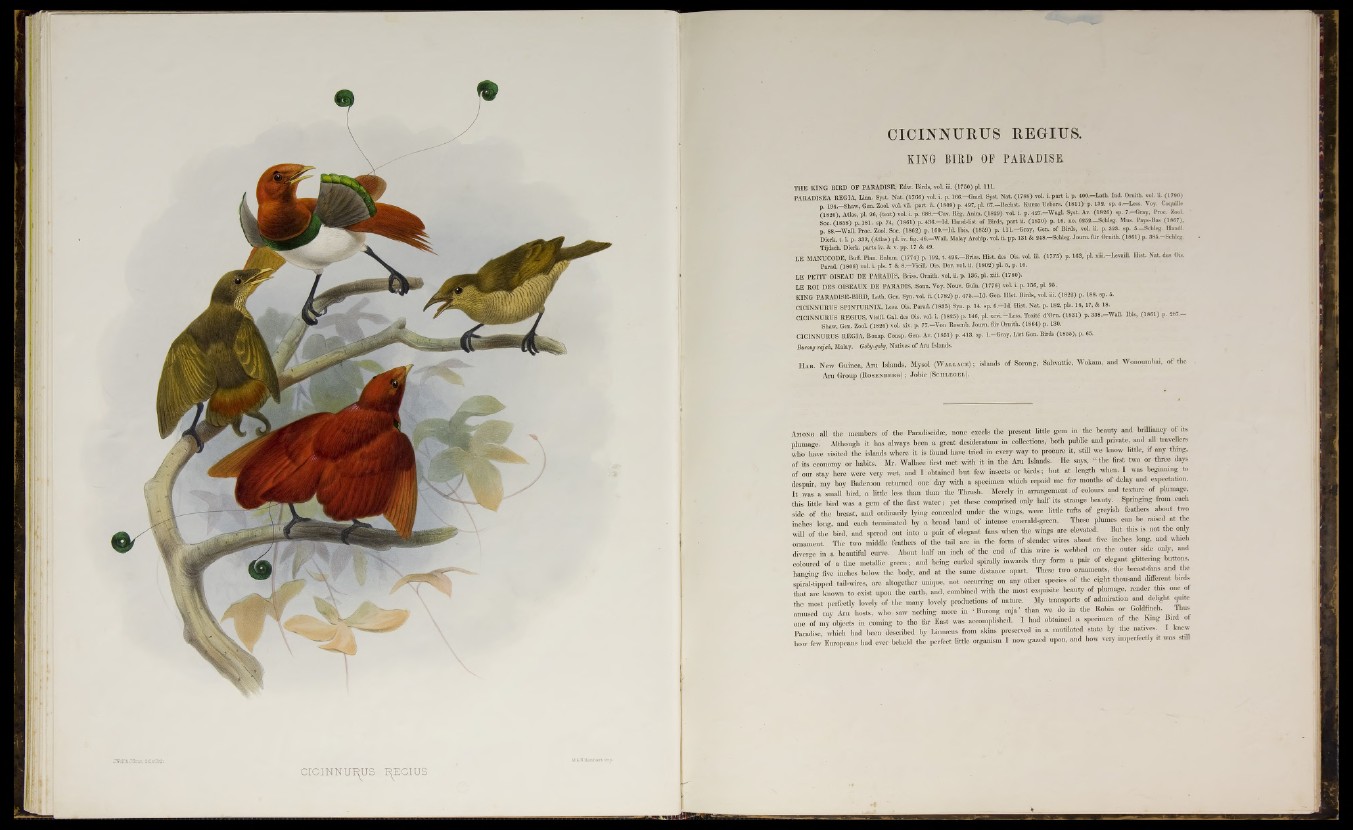
C IC INNUF^US REGIUS
CICINNURUS REGIUS.
KING BIRD OP PARADISE.
THE KING BIRD OF PARADISE, Edw. Birds, vol. iii. (1 760) pi. 111.
PARADISEA REGIA, lin n ! Syst.' Nat. (1 766) vol. i. p. 166.—Gmel. Syst. N a t (1 788) vol. i. part i. p. 400.—Lath. Ind. Ornith. vol. ii. (1790)
p. 194.—Shaw, Gen. Zool. vol. vii. part ii. (1 809) p. 497, pi. 67.—Bechst. Kurze Uebers. (1 811) p. 132. sp. 4.—Less. Voy. Coquille
(1 8 2 6 ), Atlas, pi. 26, (tex t) vol.:i. p. 688.—Cuv. Règ. Anim. (1 829) vol. i. p. 4 2 7—WagL S y s t Av. (1 826) sp. 7.—Gray, Proc. Zool.
Soc. (1 858) p. 181. sp. 74, (1 861) p. 436.—Id. Hand-list of Birds, part ii. (1 870) p. 1 6 . no. 6252.—Schleg. Mus. Pays-Bas (1867),
p. 88.—Wall., Proc. Zool. Soc. (1 862) p. 160.—Id. Ibis, (1859) p. 111.—Gray, Gen. o f Birds, vol. ii. p. 323. sp. 6.—Schleg. Handl.
Dierk. t. i. p. 332^ (Atlas) pi. iv. fig. 46.—Wall. Malay Archip. vol. ii. pp. 131 & 248.—Schleg. Journ. für Ornith. (1861) p. 385.—Schleg.
Tijdsch. Dierk. parts iv. & v. pp. 17 & 49.
LE MANUCODE, Buff. Plan. Enlum. (1774)'p. 192, t. 496.—Briss. Hist, des Ois. vol. iii. (1 7 7 5 ) p. 163, pi. xiii.—Levaill. Hist. Nat. des Ois.
Parad. (1 806) vol. i. pls.‘ 7 & 8.—Vieill. Ois. Dor. vol. ii. (1 802) pi. 5, p. 16.
LE PETIT OISEAU DE PARADIS, Briss. Ornith. vol. ii. p. 136, pi. xiii. (1760).
LE ROI DES OISEAUX DE PARADIS, Sonn. Voy. Nouv. Guin. (1 7 7 6 ) vol. i. p. 156, pl. 96.
KING PARADISE-BIRD, Lath. Gen. Syn. vol. iii (1 782) p. 475.—Id. Gen. Hist. Birds, vol. iii. (1 822) p. 188. sp. 5.
CICINNURUS SPINTURNIX, Less. Ois. Parad. (1 835) Syn. p. 14. sp /6 .—Id. Hist. Nat. p . 182, pis. 1 6 ,1 7 , & 18.
CICINNURUS REGIUS, Vieill. Gal. des Ois. vol. i. (1 8 2 5 ) p. 146, pl. x c v i.-L e ss . Traité d’Om. (1 831) p. 338.—W a ll Ibis, (1 861) p. 287.—
Shaw, Gen. Zool. (1 826) vol. xiv. p. 77.—Von Rosenb. Journ. Sir Ornith. (1864) p. 130.
CICINNURUS REGIA, Bonap. Consp. Gen. Av. (1 861) p. 413. sp. 1.—Gray, List Gen. Birds ( 1866) , p. 65.
Burong rajah, Malay. Goby-goby, Natives of Aru Islands.
H a b . New Guinea, Aru Islands, Mysol (W a l l a c e ) ; islands of Sorong, Salwattie, Wokam, and Wonoumbai, of the
Aru Group (R o s e n b e r g ) ; Jobie ( S c h l e g e l ) .
A j io k o nil the members of the, Paradiseidie, none excels the present little gem in (lie beauty and brilliancy of its
plumage. Although it has always been a great desideratum' in collections! both public and private, and all travellers
Shi>- have visited the islands where it is found have-tried in every way, to procure it, still we know little, if any thing,
of its economy or habits. Mr. Wallace first m e t'w ith 'it * the' Aru Islands.' 'He says, “ the first two or three days
of onr stay here were very wet, and I obtained but few insects or birds; hut at .length when. I was beginning to
despair, my hoy Baderoon returned one day with a specimen which repaid me for months of-delay and expectation.
It .was a small bird, a little less than than , the Thrush. Merely in arrangement-of colours' and texture of plumage,
this little bird was a gem of the first water; yet these comprised only Half its strange beauty. -Springing tom-each
side of the breast, and ordinarily lying concealed under the wings, were little tufis of greyish feathers about two
inches long, and each terminated- by a broad band of intense emerald-green. These plumes can be, raised at the
will of the bird, and spread out into a pair of elegant 6n s when the wings are elevated. But this is not die oidy
ornament The two middle feathers of the tad. are in the form of slender wires about five inches long, and which
diverge in a heautUul curve. About half mi inch of the end o f this -wire is webbed on the outer side only, and
coloured'of a fine metallic green; and being curled spirally inwards they form a pair of elegant glittering buttons,
hanging five inches below the body, and at the same distance apart. These two ornaments, the breast-fans and the
spiral-tipped tail-wires, are altogether unique, not occurring on any other species of the eight thousand different birds
that are known to exist upon, the earth, and, combined with the most exquisite beauty of plumage, render tb s one of
the most perfectly lovely of the many lovely productions of nature. My transports of admiration anddehght quite
amused my Aru hosts, who, saw nothing more in -Burong raja' t^hn we do m the Bobrn or Goldfinch. Thus
one of my objects in coming to the far East was accomplished. I had obtained a specimen of the King Bird ol
Paradise, wbch had been described by Linnseus 6om skins preserved in a mutilated state by the natives. knew
how few Europeans hod ever beheld the perfect little organism I now gaged upon, and how very imperfectly it was still